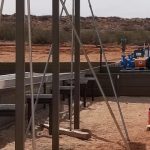What to Look for When Installing Production Tanks
July 30, 2018
Selecting where you’ll install your storage/production tank at your oil field is an extremely important decision, as it will influence the efficiency of your work site and the accessibility of the tank itself.
Here are some things you should consider when working with an oil field service in Carlsbad, NM to determine where you’ll install your next production tank:
- Spacing: If you already have storage tanks in the area, there needs to be at least a little bit of space between them. Tanks should have at least three feet of spacing between them, unless your local code requires more spacing. They should also be level with each other if installed in the same immediate area.
- Secondary containment: Your local ordinances might have provisions requiring for a secondary containment of the area for the purposes of curbing potential environmental hazards, in the event that a tank leak develops. If there’s more than one tank in the area, then you might need to use curbs or drainage channels to divide the area in separate subsections to protect each tank from potential spills from adjacent tanks.
- Dikes: Dikes are used to contain the volume of some of the tanks, depending on their contents. Their primary function is to protect the surrounding area from spills or fires from the tanks. As a general rule, the net volume of the area enclosed by the dike should be the same as the volume of the largest enclosed tank. The walls of the dike can be made with steel, concrete, solid masonry or dirt, as long as it’s watertight.
- Foundation: The foundation of the tank should always be slightly elevated, completely level and a little bit larger in diameter than the tank that will be set upon it. The area should have a slight grade that allows for easy drainage away from the tanks. Common foundation materials include:
- Ground materials, such as small gravel or crushed rock. This is the best type of grade for production tanks.
- Water and circulation, which is used to prevent water from standing underneath the tank while providing better air circulation.
- Concrete, which, if used, should be larger in diameter than the tank and have shallow grooves for better air circulation.
- Tarpaper, which can be applied to the grade and directly underneath the tank.
- Insurance: You should consider any factors of the site that could affect your insurance rates. Ideally you’ll want to achieve the lowest insurance rates possible over the lifespan of the tank.
- Other codes and standards: While these general rules are good to keep in mind, you should remember to familiarize yourself with the codes and standards in your local area. Ordinances can vary from town to town, so if you’re working in a new job site, make sure you know the rules for storage tank installation.
JB Electric LLC has a decade of experience working with oil industry clients in New Mexico. For more information about storage tank installation considerations, contact our oil field service in Carlsbad, NM.
More...
Categorised in: Oil Field Service




